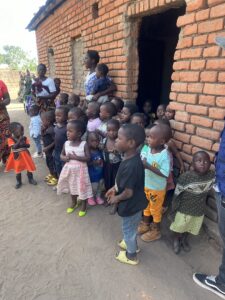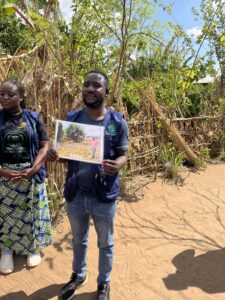Blog 4

11/12/24
Malawi III: November 7-19, 2024
Day 5 was long with a lot of driving, but was amazing. We started at Chandiwo Village where we met with Opulence Community Based Child Care (CBCC) volunteers and the children (all preschool age) they teach. School hours are Monday through Friday from 7:30am – 11:00am.
The classroom is part of a house that the owner had donated for their use, and measured about 12×12. You wouldn’t believe it unless you saw it, but they had 25+ children in this room when we arrived.
There is no electricity in the room, which is lit by ambient sunlight. There is no furniture and no chalkboard, lessons being scrawled on the walls in chalk.
While the conditions are far from optimal, the CBCC’s reported much success when the kids transition to primary school. Where children who have no preschool experience tend to struggle when they start primary school, these kids have a much higher success rate, which reportedly follows them throughout their academic careers.
From there we travelled to the villages of Chigoma and Chilolo where we learned about the installation of solar panels and lights in homes and schools. At this point, eligible homes have school age children and the homeowners pay for the units on a reduced basis over time. Hugo, Twambie, Getrude and Okhif let us know that this ownership interest by the homeowner has drastically reduced the instances of the owners selling the units (which Opulence buys for around $120/unit wholesale).
We then visited home gardens in the village of Katumbu. These gardens are the first step taken by Malawians who have received instruction from the Opulence Community Based Trainers (CBT) in the Permaculture project. The gardens were all neatly arranged (to the point that Mr. Miyagi would be jealous) and were small-scale versions of the Opulence Demonstration Farm we visited on Sunday. The principals learned and perfected in the gardens are then applied to larger scale farms by those who choose to do so. We spoke with several gardeners who all confirmed they have solved food shortage problems for their families by starting the gardens.
From there we traveled a short distance to Mzira, which is an Opulence Permaculture model village. We were greeted by local women and their jubilant singing and dancing, along with well over 100 children from the nearby primary school who apparently ditched class to see the strange new people in town. Here we witnessed the permaculture principles in full display with a full community of home gardeners and gardens. We also heard testimony from the community members who reported that, where there was bare earth two years ago, there is now life-giving produce they are able to provide to their families and even sell as surplus. Each gardener we spoke with seemed to radiate pride and enthusiasm for their efforts and the promise of food security in the future.
Next up was Chikwagula where we had the opportunity to meet and speak with three groups of Village Savings and Loan (VSL) participants and the CBT’s who oversee and train the groups. Each VSL group (sizes ranging from 15-25) had initiated a program of both selling and loaning to other group members.
The sales portion of the program is based on a need the group identified (in two of the three groups, that need is soap). The group purchases a large amount of soap at wholesale prices and then sells the soap to each other at a small markup (which is still much less than prices the members would find at a traditional market), the profit then being deposited into the group’s account. That money is the available for group members to borrow against for such purposes as the purchase of seed or animals for farming, or other goods to be sold for profit.
The majority of loans are made in April or May, and then collected in November and December. At the end of the year, each group holds a gathering where any balances owed are paid back and the group celebrates another year of profitability.
The group members were all eager to answer our questions and, to a person, agreed that any savings and loan programs employed prior to the advent of the VSL program were inferior as there was no restriction on loan amounts or guarantees on the loan being repaid.
Similar to the VSL program is the Seed Bank program, which we observed next. The program is a bit complex, but basically members can store seeds of many varieties in the bank building until such time as it is needed. The seed is used for planting or, in many instances, the seed (having been surplus from the prior year’s harvest or purchased when the market value is low) can be sold for a significant profit when the market price is higher (typically during the planting season).
As payment for the availability of storage, the bank (which is overseen by a board comprised of community members and Community Based Facilitators, or CFL’s, who are chosen to serve by the community) takes a small portion of the stored amount and then can loan that seed to other members. Those members then return the same amount of seed plus a small increase, which then increases the availability of seed to loan. Non-members can also store their seed in the bank (which is locked and guarded overnight) but are charged for the space and are not eligible for loans.
Our final stops for the day were to see the results and benefits of the solar panel project in residential and school settings. We were taken to the village of Shoti, where we were again greeted with exuberant singing and dancing by the village members. We went to the house of a member who has four children, who can now study after dark with the use of the solar powered lights and power pack that has been installed in the home. On the project houses, at least one light is installed on the exterior of the home and two inside. The benefit of the exterior light is twofold: 1) for security against theft (which is reported to have abated significantly) and 2) protection against hyenas, as the animals are afraid of lights.
We were also able to see a solar assembly that has been installed in a one-room school house, where we witnessed at least 75 students (all of whom were primary age and were studying for exams that would determine if they would be accepted into a national secondary school) sitting four to a table or on the floor, wherever they could find room. By comparison to a classroom in the U.S., the room was poorly lit and had insufficient room and resources, but by Malawian standards was a revelation as the students were able to come back after dark (and, in the case of exam week, in the middle of the night) to study.
Finally, we were treated to yet more signing and dancing by a group of young women, who have been able to practice for the last several weeks after school and chores, with the benefit of the solar lights. We learned that they had previously been unable to practice at night because of the threat of hyenas.
Their demonstration was about twenty minutes long and was deeply moving as several of our group were invited to join. We left that place with full hearts, having the gratitude of the dancers lowered on us like a warm blanket.



